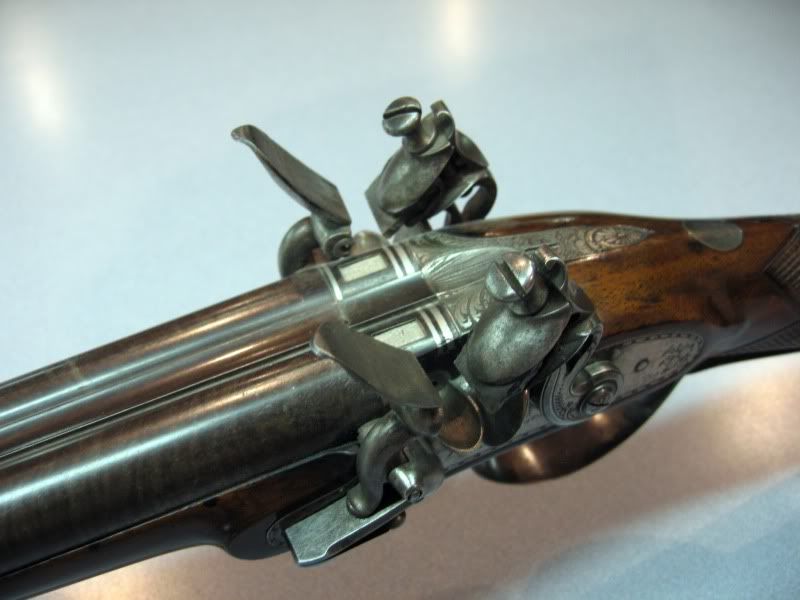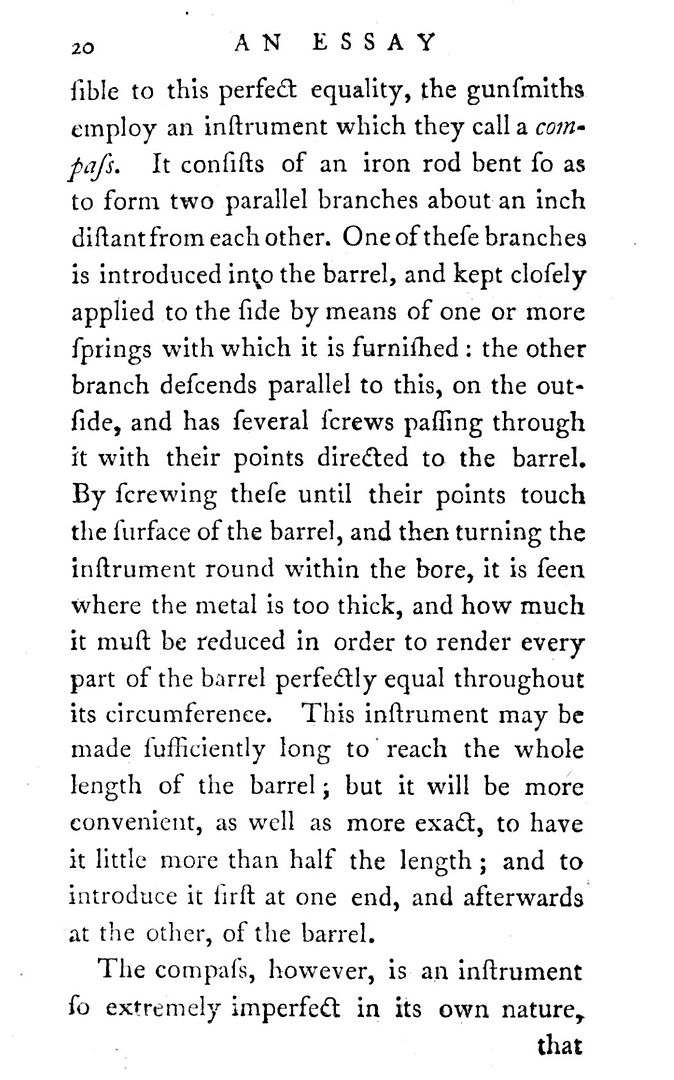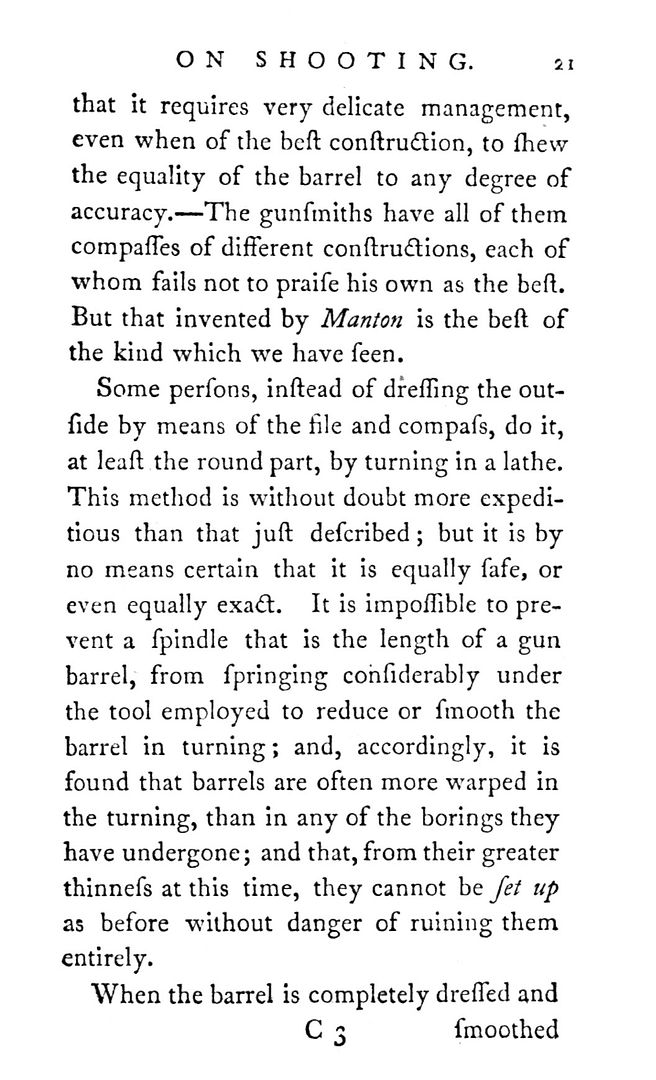|
S |
M |
T |
W |
T |
F |
S |
|
|
|
|
|
|
|
1
|
|
2
|
3
|
4
|
5
|
6
|
7
|
8
|
|
9
|
10
|
11
|
12
|
13
|
14
|
15
|
|
16
|
17
|
18
|
19
|
20
|
21
|
22
|
|
23
|
24
|
25
|
26
|
27
|
28
|
29
|
|
30
|
|
|
|
|
|
|
|
|
2 members (ithaca1, 1 invisible),
316
guests, and
3
robots. |
|
Key:
Admin,
Global Mod,
Mod
|
|
|
Forums10
Topics39,607
Posts563,352
Members14,600
| |
Most Online9,918
Jul 28th, 2025
|
|
|
|
Joined: Dec 2001
Posts: 3,971 Likes: 105
Sidelock
|

Sidelock
Joined: Dec 2001
Posts: 3,971 Likes: 105 |
Are there examples of old flintlocks that can still be used today? Ask and you shall receive..... W.H. Wilson, circa 1815, made in London. Sixteen gauge with 30" welded barrels (pre damascus). Incredibly solid and all original. Very strong locks and very, very quick ignition. Bores are near perfect and my wall thickness gauge shows it to have been struck better than any breechloader I have measured. And this was well before micrometers or any other such tools were known! But they had a mechanical tool, called a "compass" to accomplish the same thing. Picture a rod that has been shaped into a "U" about 20" long. On the end of the leg to be inserted into the bore was a ball or pin to press against the bore. On the other leg that is outside the barrel a hole was drilled through the rod and a sharpened pin was threaded through it. Inserting the "U" rod into the bore the outside pin would be hand turned till it touched metal and then the tool was turned around the barrel, making scratches on any high spots. Very simple but also very accurate. As the saying goes' "there is nothing new under the sun" . (This description is found in "An Essay On Shooting" by Cleator, 1791).  Here Are a couple pages from Essay that describes the compass:  
Last edited by Joe Wood; 09/04/16 05:13 PM.
John McCain is my war hero.
|
|
|
|
|
Joined: Feb 2002
Posts: 2,859
Sidelock
|

Sidelock
Joined: Feb 2002
Posts: 2,859 |
Joe, it's a beautiful gun but what are you doing? Anyone can see that the slots on those two screws holding the flints aren't aligned with the bore of the gun. Shameful!
Steve
Approach life like you do a yellow light - RUN IT! (Gail T.)
|
|
|
|
|
Joined: Feb 2002
Posts: 195
Sidelock
|

Sidelock
Joined: Feb 2002
Posts: 195 |
Joe--
Remarkable gun!!! And now I understand your email name!!!
Berrien
|
|
|
|
|
Joined: Jun 2002
Posts: 9,350
Sidelock
|

Sidelock
Joined: Jun 2002
Posts: 9,350 |
Not a double but flintlock: I had a mint---yes, mint---stamped 1800 on the stock Brown Bess that I used regularly for hunting and on the range until I sold it to a Connecticut antique dealer for $2,200. One of two found in an old New Brunswick barn, for which my father paid $25 each. Used it several weekends to spice up militia training with FNs. (Don't believe all stories about lousy accuracy.) Once, using too-generous powder covering ball in palm, the Brown Bess went straight-up from my hands about 15-18 inches and I caught it coming down---pure luck, all caught on 8mm Kodacolor.
|
|
|
|
|
Joined: Jan 2002
Posts: 14,061 Likes: 1859
Sidelock
|

Sidelock
Joined: Jan 2002
Posts: 14,061 Likes: 1859 |
While we know that corrosive priming certainly led to much barrel pitting, it was not/is not the only cause of it in shotguns. Before plastic shot cups came along there was precious little protection from lead scrubbing the bore. This, in time and when not cleaned properly, caused leading of the bore ...... places where a very thin piece of lead sheet was attached to the bore, built up from hundreds of times that the lead shot scrubbed along the bore wall. When this was not cleaned out thoroughly, moisture migrated underneath it, and rust began. Thus, pitting. Corrosive primers, of course, exacerbated this condition.
Not much of a problem these days, with shot cups containing the load.
SRH
Last edited by Stan; 09/04/16 04:25 PM.
May God bless America and those who defend her.
|
|
|
|
|
Joined: Apr 2012
Posts: 753
Sidelock
|

Sidelock
Joined: Apr 2012
Posts: 753 |
Not a double but flintlock: I had a mint---yes, mint---stamped 1800 on the stock Brown Bess that I used regularly for hunting and on the range until I sold it to a Connecticut antique dealer for $2,200. One of two found in an old New Brunswick barn, for which my father paid $25 each. Used it several weekends to spice up militia training with FNs. (Don't believe all stories about lousy accuracy.) Once, using too-generous powder covering ball in palm, the Brown Bess went straight-up from my hands about 15-18 inches and I caught it coming down---pure luck, all caught on 8mm Kodacolor. off the corrosion topic- the accuracy reputation of the Brown Bess was due to the undersized ball load(often one ball and three buck shot)used by the military at the time a tightly patch ball will often shoot very well out of a smooth bore-
|
|
|
|
|
Joined: Dec 2001
Posts: 3,971 Likes: 105
Sidelock
|

Sidelock
Joined: Dec 2001
Posts: 3,971 Likes: 105 |
Joe--
Remarkable gun!!! And now I understand your email name!!!
Berrien Bingo! Remains today the most complex firing mechanism ever created and very effective and reliable.
John McCain is my war hero.
|
|
|
|
|
Joined: Aug 2016
Posts: 35
Sidelock
|
OP

Sidelock
Joined: Aug 2016
Posts: 35 |
Joe, that's a beautiful gun!
A warm thank you to everyone who responded to my thread. I may be new to collecting doubles and antique firearms, but you sure made me feel welcome here. Thanks again!
|
|
|
|
|
Joined: Dec 2001
Posts: 12,743
Sidelock
|

Sidelock
Joined: Dec 2001
Posts: 12,743 |
When plastic shells first came into use many shooters experienced rusting in the chambers. Seems the older paper shells had left a wax deposit in the chambers which protected them. The plastics did not leave this wax layer & in fact left them dry & many folks it seemed did not ensure the chambers received a coat of oil when they cleaned their barrels.
Miller/TN
I Didn't Say Everything I Said, Yogi Berra
|
|
|
|
|
Joined: Oct 2004
Posts: 1,826 Likes: 12
Sidelock
|

Sidelock
Joined: Oct 2004
Posts: 1,826 Likes: 12 |
Smokeshot, why would you think any steel would loose it's strength because of age?
|
|
|
|
|